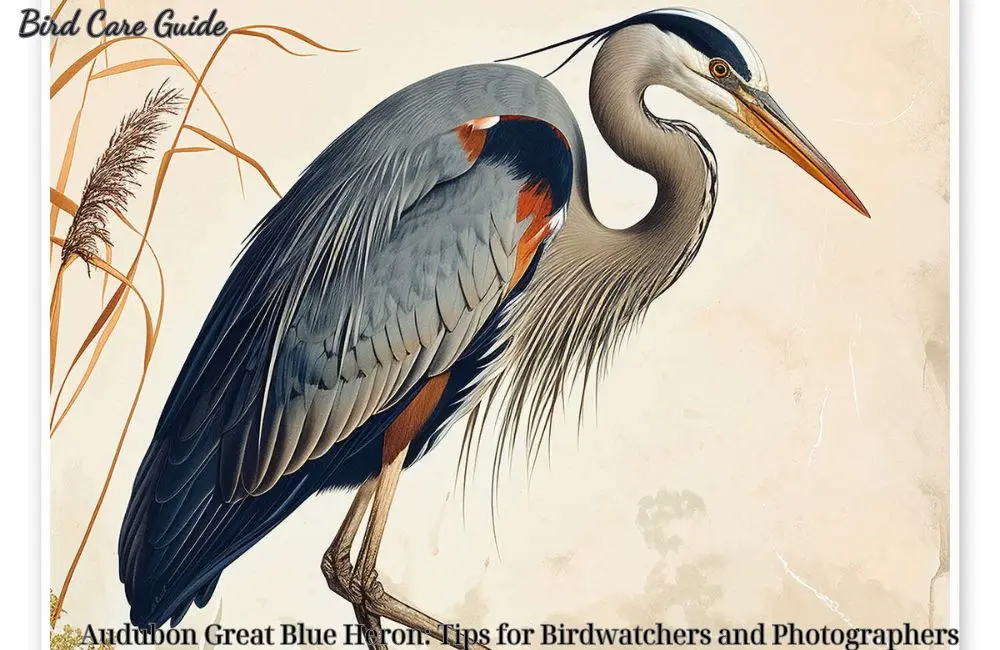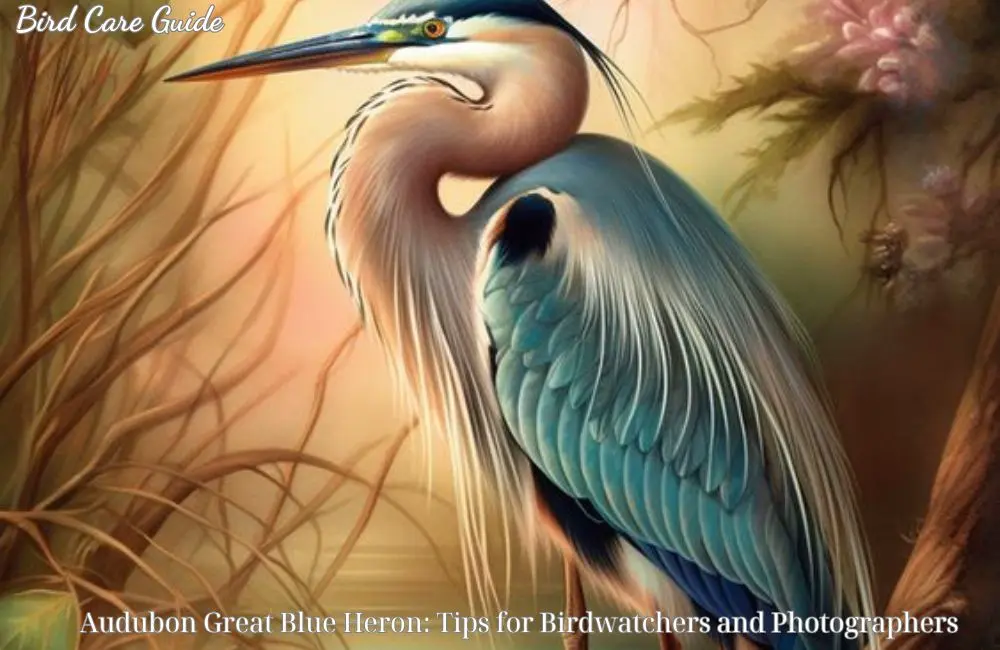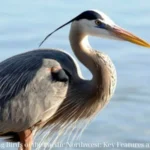The Great Blue Heron, a majestic and iconic bird found across North America, is a favorite among birdwatchers and photographers alike. Its striking appearance, graceful moveme
nts, and widespread habitat make it a captivating subject for both observation and photography. In this article, “Bird Care Guide” will delve into the world of Audubon Great Blue Heron, providing tips and insights to enhance your birdwatching and photography experiences.
Introduction to the Audubon Great Blue Heron

The Great Blue Heron (Ardea herodias) is a large wading bird commonly found near freshwater and coastal habitats across North America. It is easily recognizable by its long legs, elongated neck, and striking blue-gray plumage. These herons are adept hunters, using their sharp beaks to catch fish, frogs, and other small aquatic creatures. They are often seen standing motionless in shallow water, waiting patiently for their prey.
Named after the famous ornithologist and painter John James Audubon, the Audubon Great Blue Heron is a symbol of conservation and natural beauty. Audubon dedicated much of his life to studying and illustrating North American birds, and the Great Blue Heron was one of his favorite subjects. Today, the National Audubon Society continues his legacy, promoting bird conservation and providing resources for bird enthusiasts.
Habitat and Behavior
The Great Blue Heron is a versatile bird that inhabits a wide range of environments, from freshwater and saltwater marshes to lakeshores and coastal areas. It can be found throughout the United States, parts of Canada, and Central America. Understanding its habitat and behavior is crucial for both birdwatchers and photographers aiming to observe and capture this magnificent bird in its natural setting.
Habitat Preferences
- Wetlands: Great Blue Herons are most commonly found in wetlands, where they can hunt for fish and other aquatic prey. Look for them in marshes, swamps, and along the edges of rivers and lakes.
- Coastal Areas: These herons are also prevalent in coastal regions, including estuaries and mangroves, where they can take advantage of abundant food sources.
- Urban Areas: Surprisingly, Great Blue Herons can adapt to urban environments, often seen in city parks with ponds or along urban waterways.
Behavioral Patterns
- Foraging: Great Blue Herons are solitary foragers. They stand still or slowly wade through the water, striking quickly with their sharp bills to catch prey.
- Nesting: They typically nest in colonies known as rookeries, often in tall trees or shrubs near water. Nesting season varies by region but generally occurs in the spring.
- Flight: These birds are strong fliers, often seen gliding with slow, deep wingbeats. They tuck their necks in an S-shape during flight, which distinguishes them from cranes.
Birdwatching Tips for Observing the Great Blue Heron
1. Know Their Habitats:
Great Blue Herons prefer wetland habitats. Look for them in areas with shallow water where they can wade and hunt for fish, amphibians, and small mammals. Estuaries, marshes, and the edges of lakes and rivers are prime locations.
2. Timing is Key:
Early morning and late afternoon are the best times to observe Great Blue Herons. They are most active during these times, hunting for food. Additionally, the soft light during these periods provides excellent conditions for viewing and photography.
3. Use Binoculars or a Spotting Scope:
To get a closer look at the Great Blue Heron without disturbing it, use binoculars or a spotting scope. This equipment allows you to observe their behavior, such as hunting techniques and interactions with other birds, from a distance.
4. Approach Quietly:
Great Blue Herons are sensitive to disturbances. Approach quietly and slowly to avoid startling them. If you notice the bird becoming alert or agitated, stop and wait for it to resume its normal behavior.
5. Observe Nesting Sites:
During breeding season, typically from March to May, look for nesting colonies known as rookeries. These are often located in trees near water. Observing a rookery can provide insights into their nesting behavior and the raising of young.
6. Learn Their Behaviors:
Understanding the behaviors of Great Blue Herons can enhance your birdwatching experience. For example, they are known for their slow, deliberate movements when hunting and their striking “S-shaped” neck posture.
Photography Tips for Capturing the Great Blue Heron
1. Optimal Camera Settings:
To capture the intricate details of the Great Blue Heron, use a fast shutter speed (1/1000th of a second or faster) to freeze motion, especially when they are in flight. A mid-range aperture (f/8 to f/11) ensures a good depth of field, keeping both the bird and the background in focus.
2. Use a Telephoto Lens:
A telephoto lens with a focal length of 300mm or more is ideal for photographing Great Blue Herons. This allows you to get close-up shots without disturbing the bird. A teleconverter can extend your reach further.
3. Shoot in Burst Mode:
Great Blue Herons can move quickly, especially when taking off or catching prey. Shooting in burst mode increases your chances of capturing the perfect moment.
4. Focus on the Eyes:
In wildlife photography, the eyes are the most critical focal point. Ensure that the heron’s eyes are sharp and in focus, as they draw viewers into the image.
5. Capture Different Angles:
Vary your shots by capturing the heron from different angles. Side profiles, front views, and shots of the bird in flight can provide a diverse and compelling portfolio of images.
6. Utilize Natural Light:
The best lighting conditions for photographing Great Blue Herons are during the golden hours—shortly after sunrise and before sunset. The warm, soft light during these times enhances the bird’s colors and creates a pleasing atmosphere.
7. Incorporate the Habitat:
Including elements of the heron’s habitat in your photos adds context and tells a more complete story. Capture the bird wading in water, perched on a tree, or in a rookery to showcase its natural environment.
8. Be Patient:
Wildlife photography requires patience. Spend time observing the heron’s behavior and wait for the right moment to take your shot. Patience often results in more natural and compelling images.
The Joy of Birdwatching and Photography
Birdwatching and photography are not just hobbies; they are opportunities to connect with nature and contribute to conservation efforts. The Great Blue Heron, with its grace and beauty, offers an ideal subject for both activities. Whether you’re observing their behavior or capturing their elegance through a lens, the experience can be profoundly rewarding.
Conservation and Ethical Considerations
As a birdwatcher or photographer, it’s essential to respect the Great Blue Heron and its habitat.
Ethical Birdwatching and Photography
Respecting wildlife and their habitats is paramount in both birdwatching and photography. Here are some guidelines to ensure ethical practices:
- Maintain Distance: Keep a respectful distance to avoid disturbing the herons, especially during nesting season.
- Do Not Feed: Feeding wild birds can disrupt their natural foraging behavior and may lead to dependency on humans.
- Stay on Trails: Stick to designated trails and paths to minimize your impact on the habitat.
- Leave No Trace: Follow the principles of Leave No Trace. Take all your belongings and trash with you, leaving the environment as you found it.
Engaging with the Audubon Community
Joining birdwatching and photography groups, both online and offline, can enhance your experience and knowledge. The Audubon Society offers resources, events, and communities for bird enthusiasts.
- Local Audubon Chapters: Many regions have local Audubon chapters that organize birdwatching trips, workshops, and conservation activities. Participating in these events can provide valuable learning opportunities and foster a sense of community.
- Online Forums and Social Media: Engage with other birdwatchers and photographers on platforms like Facebook, Instagram, and birding forums. Sharing your experiences and learning from others can be incredibly enriching.
- Citizen Science Projects: Contribute to citizen science projects by submitting your bird sightings and photographs to databases like eBird. Your observations can aid in research and conservation efforts.
Conclusion
The Audubon Great Blue Heron is a fascinating and majestic bird that offers endless opportunities for birdwatchers and photographers to connect with nature. By understanding its habitat, behavior, and employing the right techniques, you can enhance your birdwatching and photography experience. Remember to practice ethical birdwatching and photography, respect wildlife, and engage with the community to share and learn from others. Whether you are a seasoned birdwatcher or a novice photographer, the Great Blue Heron promises to captivate and inspire.





